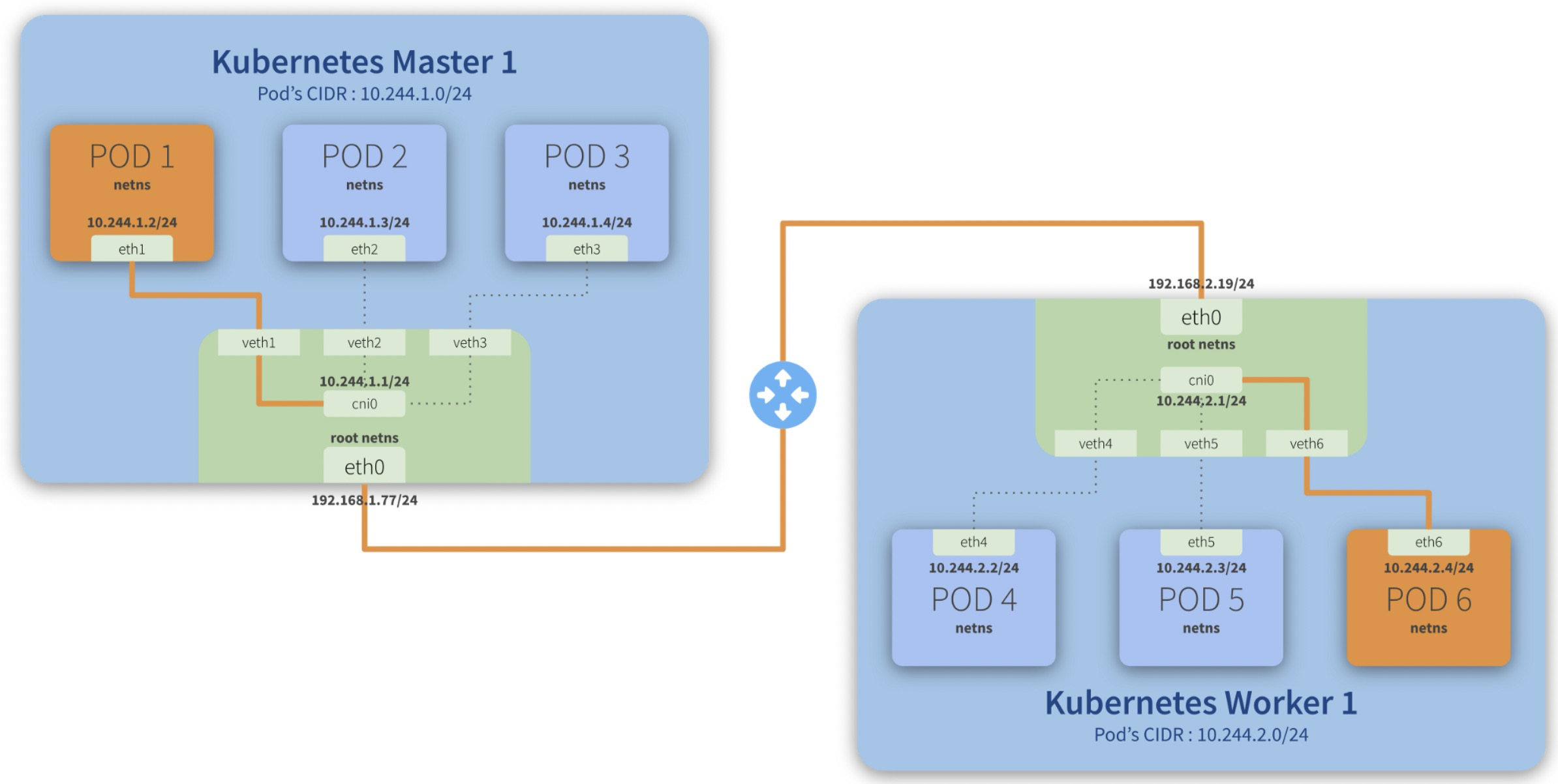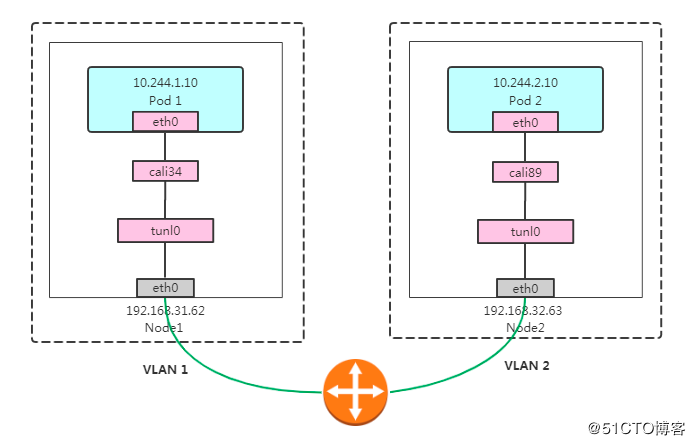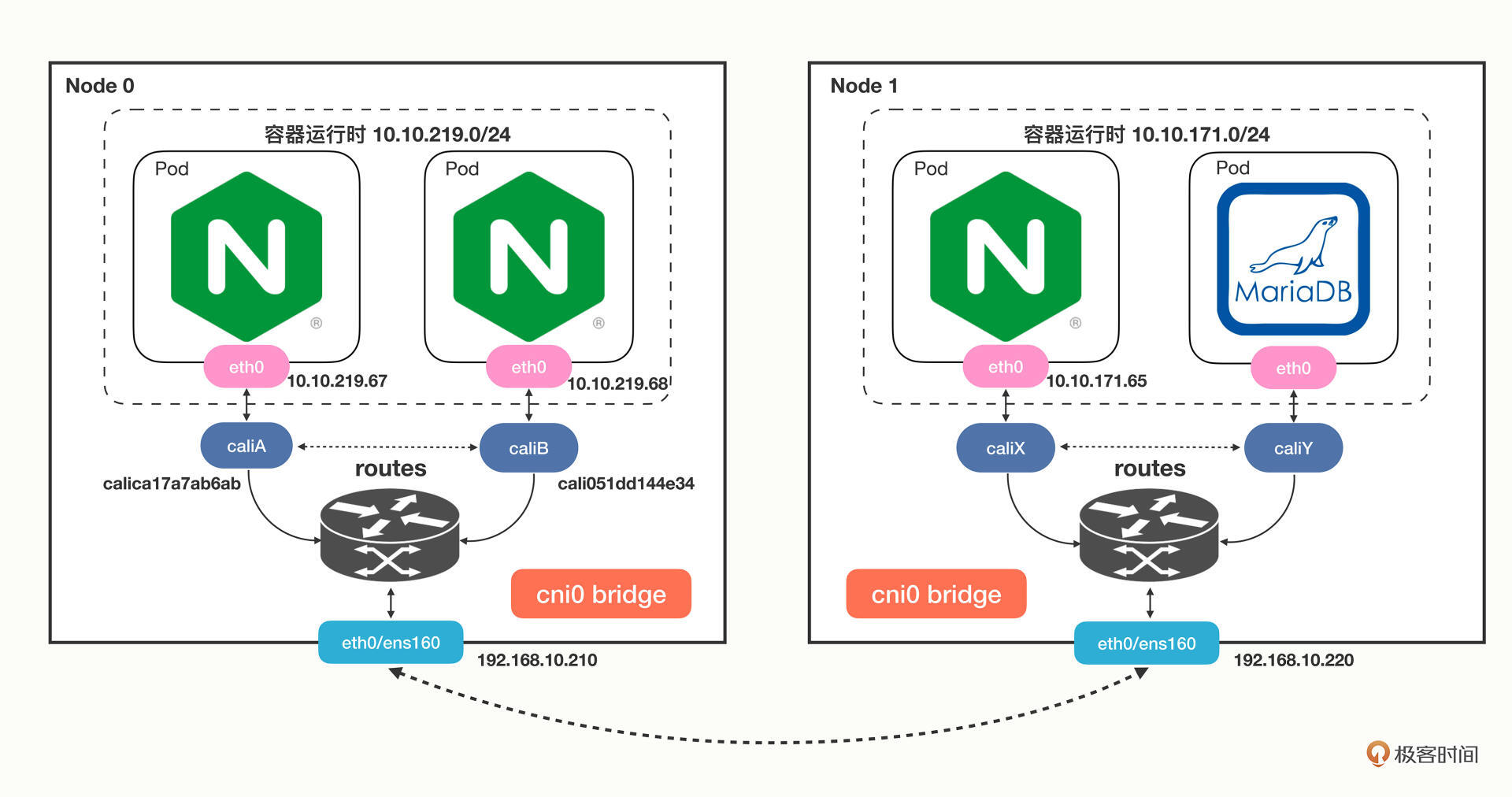kubernetes calico网络
cni 网络
cni0 is a Linux network bridge device, all veth devices will connect to this bridge, so all Pods on the same node can communicate with each other, as explained in Kubernetes Network Model and the hotel analogy above.
cni(Container Network Interface)
CNI 全称为 Container Network Interface,是用来定义容器网络的一个 规范。containernetworking/cni 是一个 CNCF 的 CNI 实现项目,包括基本额 bridge,macvlan等基本网络插件。
一般将cni各种网络插件的可执行文件二进制放到 /opt/cni/bin ,在 /etc/cni/net.d/ 下创建配置文件,剩下的就交给 K8s 或者 containerd 了,我们不关心也不了解其实现。
比如:
|
|
CNI 插件都是直接通过 exec 的方式调用,而不是通过 socket 这样 C/S 方式,所有参数都是通过环境变量、标准输入输出来实现的。
Step-by-step communication from Pod 1 to Pod 6:
- Package leaves Pod 1 netns\ through the eth1\ interface and reaches the root netns\ through the virtual interface veth1*;*
- Package leaves veth1\ and reaches cni0*, looking for **Pod 6***’s address;
- Package leaves cni0\ and is redirected to eth0*;*
- Package leaves eth0\ from Master 1\ and reaches the gateway*;*
- Package leaves the gateway\ and reaches the root netns\ through the eth0\ interface on Worker 1*;*
- Package leaves eth0\ and reaches cni0*, looking for **Pod 6***’s address;
- Package leaves cni0\ and is redirected to the veth6\ virtual interface;
- Package leaves the root netns\ through veth6\ and reaches the Pod 6 netns\ though the eth6\ interface;

kubernetes calico 网络
|
|
默认calico用的是ipip封包(这个性能跟原生网络差多少有待验证,本质也是overlay网络,比flannel那种要好很多吗?)
跨宿主机的两个容器之间的流量链路是:
cali-容器eth0->宿主机cali27dce37c0e8->tunl0->内核ipip模块封包->物理网卡(ipip封包后)—远程–> 物理网卡->内核ipip模块解包->tunl0->cali-容器

Calico IPIP模式对物理网络无侵入,符合云原生容器网络要求;使用IPIP封包,性能略低于Calico BGP模式;无法使用传统防火墙管理、也无法和存量网络直接打通。Pod在Node做SNAT访问外部,Pod流量不易被监控。

calico ipip网络不通
集群有五台机器192.168.0.110-114, 同时每个node都有另外一个ip:192.168.3.110-114,部分节点之间不通。每台机器部署好calico网络后,会分配一个 /26 CIRD 子网(64个ip)。
案例1
目标机是10.122.127.128(宿主机ip 192.168.3.112),如果从10.122.17.64(宿主机ip 192.168.3.110) ping 10.122.127.128不通,查看10.122.127.128路由表:
|
|
在10.122.127.128抓包如下,明显可以看到icmp request到了 tunl0网卡,tunl0网卡也回复了,但是回复包没有经过kernel ipip模块封装后发到eth1上:

正常机器应该是这样,上图不正常的时候缺少红框中的reply:

解决:
|
|
删除错误路由增加新的路由就可以了,新增路由的意思是从tunl0发给10.122.17.64/26的包下一跳是 192.168.3.110。
via 192.168.3.110 表示下一跳的ip
onlink参数的作用:
使用这个参数将会告诉内核,不必检查网关是否可达。因为在linux内核中,网关与本地的网段不同是被认为不可达的,从而拒绝执行添加路由的操作。
因为tunl0网卡ip的 CIDR 是32,也就是不属于任何子网,那么这个网卡上的路由没有网关,配置路由的话必须是onlink, 内核存也没法根据子网来选择到这块网卡,所以还会加上 dev 指定网卡。
案例2
集群有五台机器192.168.0.110-114, 同时每个node都有另外一个ip:192.168.3.110-114,只有node2没有192.168.3.111这个ip,结果node2跟其他节点都不通:
|
|
从node4 ping node2,然后在node2上抓包,可以看到 icmp request都发到了node2上,但是node2收到后没有发给tunl0:

所以icmp没有回复,这里的问题在于kernel收到包后为什么不给tunl0
同样,在node2上ping node4,同时在node2上抓包,可以看到发给node4的request包和reply包:

从request包可以看到src ip 是0.111, dest ip是 3.113,因为 node2 没有192.168.3.111这个ip
非常关键的我们看到node4的回复包 src ip 不是3.113,而是0.113(根据node4的路由就应该是0.113)

这就是问题所在,从node4过来的ipip包src ip都是0.113,实际这里ipip能认识的只是3.113.
如果这个时候在3.113机器上把0.113网卡down掉,那么3.113上的:
10.122.124.128/26 via 192.168.0.111 dev tunl0 proto bird onlink 路由被自动删除,3.113将不再回复request。这是因为calico记录的node2的ip是192.168.0.111,所以会自动增加
解决办法,在node4上删除这条路由记录,也就是强制让回复包走3.113网卡,这样收发的ip就能对应上了
|
|
最终OK后,node4上的ip route是这样的:
|
|
正常后的抓包, 注意这里reques dest ip 和reply的 src ip终于一致了:
|
|
总结下来这两个案例都还是对路由不够了解,特别是案例2,因为有了多个网卡后导致路由更复杂。calico ipip的基本原理就是利用内核进行ipip封包,然后修改路由来保证网络的畅通。
参考资料
https://morven.life/notes/networking-3-ipip/
https://www.cnblogs.com/bakari/p/10564347.html